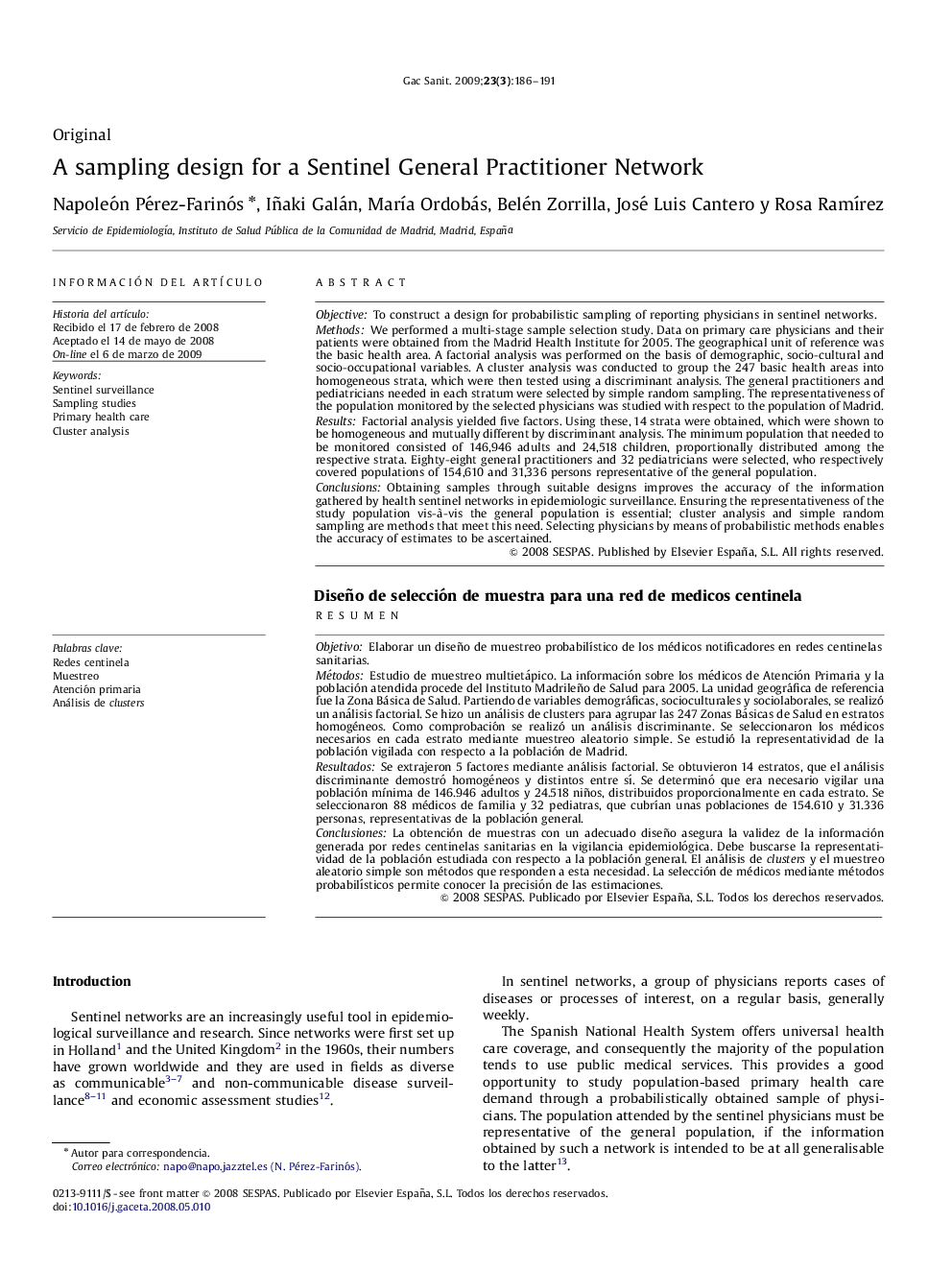| کد مقاله | کد نشریه | سال انتشار | مقاله انگلیسی | نسخه تمام متن |
|---|---|---|---|---|
| 1073756 | 949799 | 2009 | 6 صفحه PDF | دانلود رایگان |

ObjectiveTo construct a design for probabilistic sampling of reporting physicians in sentinel networks.MethodsWe performed a multi-stage sample selection study. Data on primary care physicians and their patients were obtained from the Madrid Health Institute for 2005. The geographical unit of reference was the basic health area. A factorial analysis was performed on the basis of demographic, socio-cultural and socio-occupational variables. A cluster analysis was conducted to group the 247 basic health areas into homogeneous strata, which were then tested using a discriminant analysis. The general practitioners and pediatricians needed in each stratum were selected by simple random sampling. The representativeness of the population monitored by the selected physicians was studied with respect to the population of Madrid.ResultsFactorial analysis yielded five factors. Using these, 14 strata were obtained, which were shown to be homogeneous and mutually different by discriminant analysis. The minimum population that needed to be monitored consisted of 146,946 adults and 24,518 children, proportionally distributed among the respective strata. Eighty-eight general practitioners and 32 pediatricians were selected, who respectively covered populations of 154,610 and 31,336 persons representative of the general population.ConclusionsObtaining samples through suitable designs improves the accuracy of the information gathered by health sentinel networks in epidemiologic surveillance. Ensuring the representativeness of the study population vis-à-vis the general population is essential; cluster analysis and simple random sampling are methods that meet this need. Selecting physicians by means of probabilistic methods enables the accuracy of estimates to be ascertained.
ResumenObjetivoElaborar un diseño de muestreo probabilístico de los médicos notificadores en redes centinelas sanitarias.MétodosEstudio de muestreo multietápico. La información sobre los médicos de Atención Primaria y la población atendida procede del Instituto Madrileño de Salud para 2005. La unidad geográfica de referencia fue la Zona Básica de Salud. Partiendo de variables demográficas, socioculturales y sociolaborales, se realizó un análisis factorial. Se hizo un análisis de clusters para agrupar las 247 Zonas Básicas de Salud en estratos homogéneos. Como comprobación se realizó un análisis discriminante. Se seleccionaron los médicos necesarios en cada estrato mediante muestreo aleatorio simple. Se estudió la representatividad de la población vigilada con respecto a la población de Madrid.ResultadosSe extrajeron 5 factores mediante análisis factorial. Se obtuvieron 14 estratos, que el análisis discriminante demostró homogéneos y distintos entre sí. Se determinó que era necesario vigilar una población mínima de 146.946 adultos y 24.518 niños, distribuidos proporcionalmente en cada estrato. Se seleccionaron 88 médicos de familia y 32 pediatras, que cubrían unas poblaciones de 154.610 y 31.336 personas, representativas de la población general.ConclusionesLa obtención de muestras con un adecuado diseño asegura la validez de la información generada por redes centinelas sanitarias en la vigilancia epidemiológica. Debe buscarse la representatividad de la población estudiada con respecto a la población general. El análisis de clusters y el muestreo aleatorio simple son métodos que responden a esta necesidad. La selección de médicos mediante métodos probabilísticos permite conocer la precisión de las estimaciones.
Journal: Gaceta Sanitaria - Volume 23, Issue 3, May–June 2009, Pages 186–191